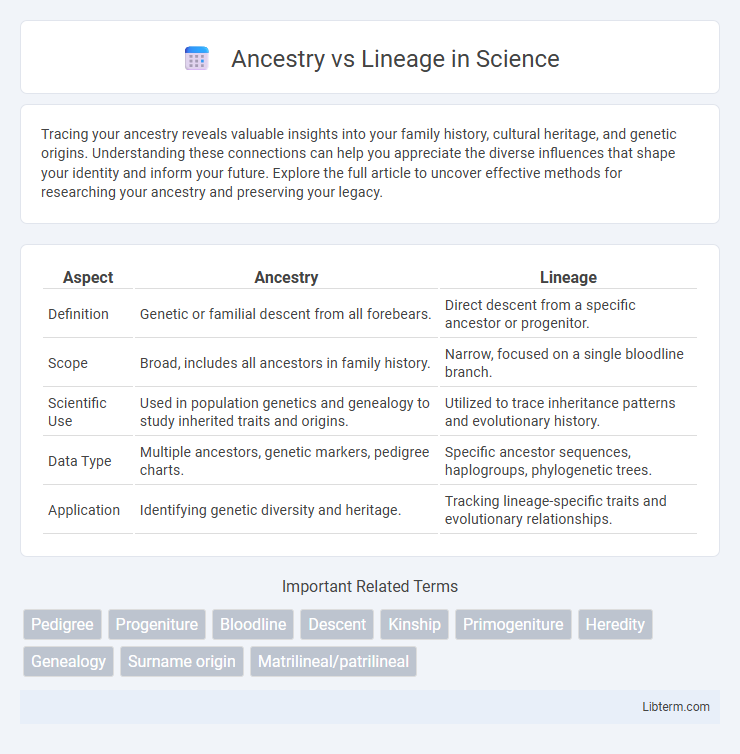Tracing your ancestry reveals valuable insights into your family history, cultural heritage, and genetic origins. Understanding these connections can help you appreciate the diverse influences that shape your identity and inform your future. Explore the full article to uncover effective methods for researching your ancestry and preserving your legacy.
Table of Comparison
| Aspect | Ancestry | Lineage |
|---|---|---|
| Definition | Genetic or familial descent from all forebears. | Direct descent from a specific ancestor or progenitor. |
| Scope | Broad, includes all ancestors in family history. | Narrow, focused on a single bloodline branch. |
| Scientific Use | Used in population genetics and genealogy to study inherited traits and origins. | Utilized to trace inheritance patterns and evolutionary history. |
| Data Type | Multiple ancestors, genetic markers, pedigree charts. | Specific ancestor sequences, haplogroups, phylogenetic trees. |
| Application | Identifying genetic diversity and heritage. | Tracking lineage-specific traits and evolutionary relationships. |
Understanding Ancestry and Lineage: Key Definitions
Ancestry refers to the complete genetic or familial descent from all forebears, encompassing all branches of a person's family tree. Lineage specifically traces a direct line of descent from a particular ancestor, often focusing on paternal or maternal lines. Understanding these definitions helps differentiate between broad genealogical connections and specific familial lines used in historical and genetic research.
Historical Perspectives on Ancestors and Lineal Descent
Historical perspectives on ancestry and lineage highlight the importance of tracking ancestors to establish identity and heritage, with ancestry encompassing a broader familial network while lineage traces a direct lineal descent through generations. Ancient civilizations often recorded lineages to assert social status, inheritance rights, and cultural continuity, emphasizing patrilineal or matrilineal descent depending on societal norms. These records, including genealogies, royal chronicles, and oral traditions, served as critical tools for maintaining historical memory and legitimizing authority across time.
Cultural Differences in Tracing Family Roots
Cultural differences in tracing family roots significantly influence how ancestry and lineage are understood and documented across societies. In Western cultures, ancestry often emphasizes individual genetic descent through documented records and DNA testing, while many Indigenous and non-Western traditions prioritize lineage through oral histories, clan affiliations, and matrilineal or patrilineal descent systems. These diverse methods reflect varying values placed on biological connections versus social or spiritual ties, shaping unique narratives of identity and heritage worldwide.
Genetic Ancestry: Science Behind Your Origins
Genetic ancestry explores the science behind your origins by analyzing DNA markers inherited from your ancestors to trace lineage and population migrations over millennia. Techniques such as autosomal, mitochondrial, and Y-chromosome DNA testing reveal distinct genetic signatures that map ethnic backgrounds and ancestral connections with scientific precision. Understanding genetic ancestry bridges personal identity and evolutionary history through advanced genomics and bioinformatics tools.
Documenting Lineage: Tools and Techniques
Documenting lineage relies heavily on genetic testing tools such as Y-DNA and mitochondrial DNA analysis, which provide precise insights into direct paternal and maternal lines. Historical records, including birth, marriage, and death certificates, complement DNA evidence by validating generational connections within a family tree. Advanced genealogy software integrates these data sources, facilitating detailed lineage mapping and ensuring accuracy in tracing hereditary relationships over multiple generations.
Ancestry Records vs. Lineage Documents
Ancestry records typically consist of birth, marriage, and death certificates, census data, and immigration logs that provide factual evidence of an individual's familial connections across generations. Lineage documents, however, emphasize verified genealogical proof such as lineage society membership papers, wills, and land deeds, confirming direct descent from specific ancestors. These distinctions highlight how ancestry records offer broad family history data, while lineage documents focus on authenticated proof essential for heritage verification.
Family Trees: Mapping Ancestry and Lineage
Family trees serve as detailed visual representations of both ancestry and lineage, mapping generations of individuals through direct bloodlines and extended relatives. Ancestry highlights the biological connections tracing back to ancestors, while lineage emphasizes the continuous descent from a specific ancestor or family origin. These mapped relationships in family trees enable genealogical research, revealing patterns of heritage, inheritance, and family history.
Importance of Ancestry and Lineage in Modern Society
Ancestry and lineage provide critical insights into individual identity, cultural heritage, and genetic inheritance, influencing medical research, legal rights, and social connections in modern society. Understanding ancestry helps trace familial origins and migratory patterns, while lineage preserves traditions and strengthens community bonds across generations. Both concepts are essential for fostering a sense of belonging and informing personal and collective history in contemporary life.
Common Misconceptions About Ancestry and Lineage
Common misconceptions about ancestry and lineage often confuse the two as interchangeable terms, but ancestry refers broadly to all genetic heritage from ancestors, whereas lineage specifically traces direct descent through a single line, such as paternal or maternal. Many mistakenly believe lineage includes all relatives equally, ignoring that it emphasizes a clear, unbroken line of descent crucial for genealogical accuracy. Understanding these distinctions improves clarity in genealogical research and cultural identity studies.
Choosing the Right Approach for Tracing Your Family History
Choosing the right approach for tracing your family history depends on whether you prioritize broad genetic connections or detailed familial relationships. Ancestry provides a comprehensive view of genetic origins and ethnic composition through DNA testing, ideal for uncovering deep-rooted heritage across continents. Lineage focuses on direct genealogical descent, emphasizing documented family trees and historical records to trace specific ancestors and familial lines with greater precision.
Ancestry Infographic

 libterm.com
libterm.com